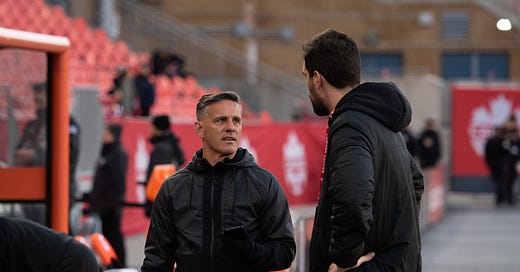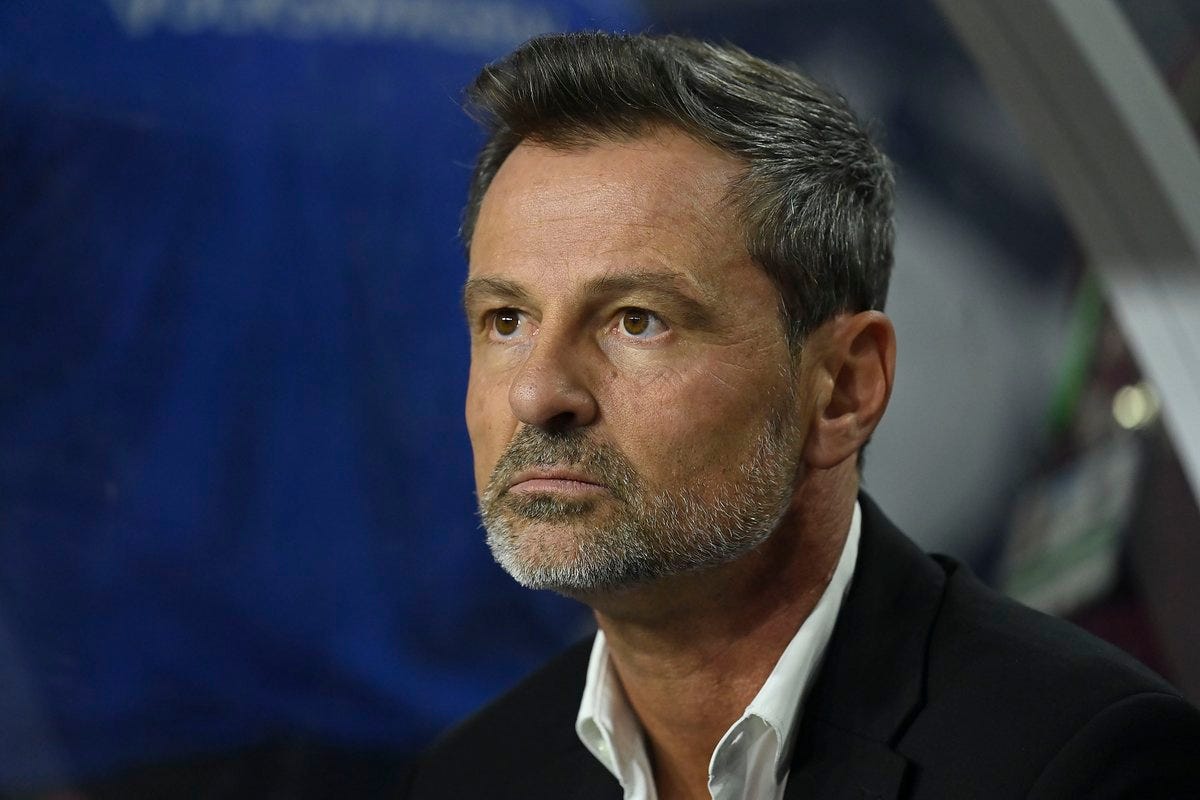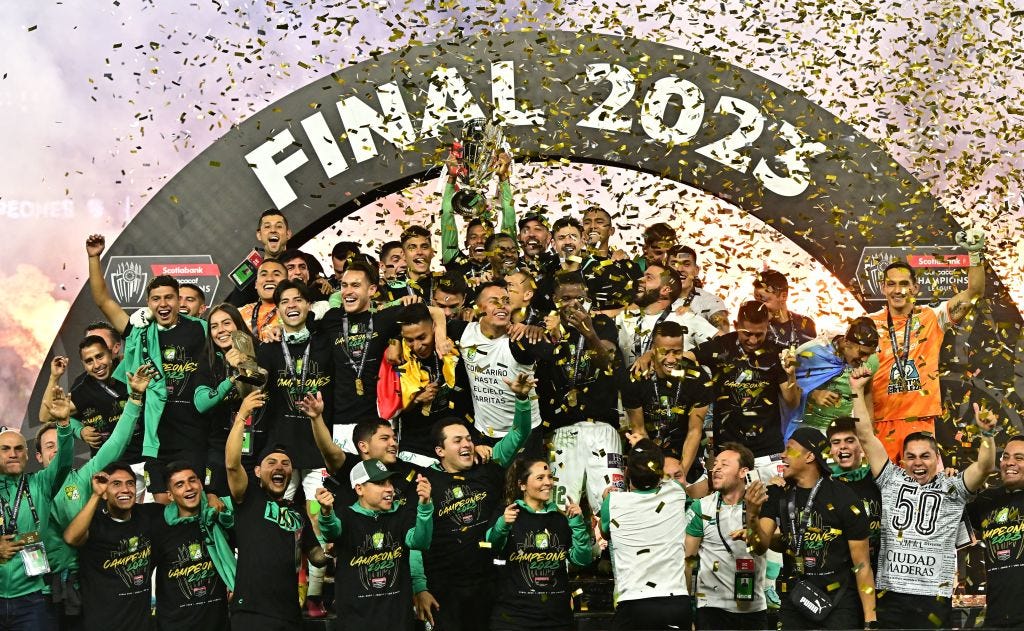🤔 The finalists' dilemma
Nations League? Gold Cup? Or both? PLUS: The CCL is gone; Long live the CCC
Say you’re John Herdman.
For the last few years, the job as Canada’s men’s national team manager has been really clear. The goals have been obvious. And you’ve mostly achieved those goals.
The World Cup wasn’t great, but you got the team there, finishing first in qualification and returning to a World Cup for the first time
And, after Qatar you did what you needed to do in the Concacaf Nations League, topping the group and earning a place in next week’s Final Four. Just after that comes the Gold Cup, with your best squad in decades shaping up as true contenders.
Do you name a roster that gives you the best chance to win the Nations League? Do you let those players rest and put your eggs in the Gold Cup basket? Do a mix?
This is the manager’s dilemma ahead of a busy summer.
You can win two games in five days and lift the first trophy for Canada’s men since the 2000 Gold Cup triumph. Or you can bring in your best players for the long Gold Cup run, looking to become champions of the region, staking a claim as true Kings of Concacaf after topping the WCQ heap and lifting the continental cup.
Or, of course, you can try for both.
Tomorrow we’ll learn what the actual John Herdman is going to do when he speaks to the press after announcing his final CNL squad. He has the benefit of being able to call up the leaders of Canada Soccer, but beyond that rotating cast of business types, he answers to the fan base.
Delivering a trophy to Canada would be a big achievement. It’s the next logical step as Canadian men’s soccer continues to evolve into a habitual contender for the region’s top prizes.
As Canada forward Cyle Larin put it when I spoke with him last month for an MLS piece: “It’s time. Everyone wants to win something, to go into these Nations League games and win a trophy and go into the Gold Cup and win a trophy.”
Plus, there’s the added bonus of having something to point to as fans with increasingly high expectations wonder if the team really is making enough progress and as a new boss arrives ahead of the 2026 World Cup taking place partially on Canadian soil.
Herdman isn’t the only manager working out the best way to lift at least one trophy this summer.
Gregg Berhalter, sorry, Antho-oh, wait, Anthony Hudson BJ Callaghan likely will deploy the same strategy the U.S. used last time around. After all, splitting the squad worked with the U.S. winning both the Nations League and the Gold Cup. Can they do that under the interim to the interim manager? That’s another question.
The other two managers in the Final Four will take a different approach.
Mexico manager Diego Cocca is utilizing the bulk of his squad for both the Nations League and the Gold Cup.
His calculus is different. While Canada fans would likely be happy with just one trophy, and U.S. fans are ready to shrug off any summer struggles after the managerial shifts, Mexico fans want to win both competitions. They expect to win both competitions.
So, there’s Guillermo Ochoa ready to spend his entire summer with El Tri after a long season in Italy. There’s Julian Araujo despite needing to fight for a spot in Barcelona. There’s Cesar Montes, Edson Alvarez, Sebastian Cordova fresh off the Liga MX title. The whole (healthy) gang is here for both tournaments.
Panama manager Thomas Christiansen has to cope with something a bit different. While Panama’s ranks are growing, the player pool still isn’t as deep as the North American rivals.
He doesn’t have the luxury of even considering whether or not to split his squad. To compete with Canada in the CNL semifinal and to try to make a deep Gold Cup run, Christiansen needs his top players in each competition.
This dilemma for managers isn’t something Concacaf really wanted. The Nations League finals will shift to their planned place in March starting in 2024, meaning teams will be able to bring in their top rosters as they would for a typical FIFA date. They won’t have to worry about bringing players in for a full month just a few weeks later, potentially disrupting preseason preparations with European clubs or frustrating MLS teams with a handful of matches during the tournaments.
The pandemic meant the schedule had to be condensed, first two years ago and now this summer. Soon enough, there will be juuuust a bit more breathing room before the 2024 Copa América, a Gold Cup the next summer that
For now? The right answer for managers is only the one that ends in success.
The U.S. split their squads and lifted both trophies in 2021. Can that still happen in a more settled and competitive environment two years later? Those fortunate four managers putting squads together for both tournaments have been pondering that question for months, with the answer only being revealed as the confetti rains down twice this summer.
Goodbye CCL, hello again Concacaf Champions Cup
Concacaf announced a branding change for its top men’s club competition Tuesday, putting to rest the use of the Concacaf Champions League name used between 2008-2023 and returning to the Concacaf Champions Cup.
In its media release, the confederation played up the history of the CCC name, with champions that now feel quite antiquated. Teams from Suriname, from Haiti, from El Salvador have been the champion, something that feels impossible now.
A nod to history is welcome from a governing body that too often forgets it has a history.
Yet, this competition will be very different than anything Transvaal or Aguila won in the 1970s - in a lot of good ways.
We already knew the structure of the tournament would change, expanding as the Club World Cup also expands - and as organizers look to pit Liga MX teams against MLS teams more often and push other regional rivalries.
But Tuesday’s announcement brought a few new details that should have fans excited about the possibility games in this competition will be worth watching.
The champion will receive $5 million in prize money and dispersals - something I actually misinterpreted in the news release. Why? Because the previous pot was $1 million, with the champion earning $500,000.
The champion earning five times what the previous pot for the entire tournament netted is a significant boost in prize money, still not in line with rival competitions like the Copa Libertadores but at least something team owners may want to play for. Even if they fall short, a deep run could earn a decent financial reward.
The other difference from the Champions Cups of days gone by is that rather than teams traveling to one location and playing a quick one-site tournament, we’ll have the mostly familiar home-and-away, two-legged series.
It’s easier to travel now. Teams typically don’t have to pull out of competitions because of difficulty traveling. It’s easier to level the playing field in an effort to determine who really is the best team in the region.
As the world has changed, so too has our soccer landscape, currently dominated by North American teams. Liga MX clubs won all but one title in the CCL era, and MLS teams continue to improve and spend more money in an effort to catch them and surpass them.
Deeper than just the CCC branding and structure, Concacaf needs the Central American and Caribbean competitions it’s launching to work and achieve the goal of increasing competition amongst teams in those areas, encouraging investment and sponsorship so teams from those subregions can truly compete.
Finding a way to help teams like those in Guatemala, Haiti and beyond to actually have a shot against the big-money clubs in Mexico and the U.S. would be the most transformative thing Concacaf could do to make its competition a must-watch.
For now, increased clashes between Liga MX and MLS teams, a fun throwback name, and a bigger pot at the end of the rainbow will put the competition on a good launch pad for the first few years of its existence.








